Our great friend Jan van der Vliet shows us his bookshelf today and asks What Errol Flynn books have you read?
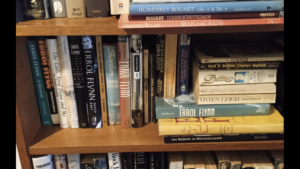
Thanks, Jan …
— David DeWitt
Our great friend Jan van der Vliet shows us his bookshelf today and asks What Errol Flynn books have you read?

Thanks, Jan …
— David DeWitt
Posted in Books about Flynn, Collectibles, Flynn-related, Mail Bag
Before Errol Flynn owned the Zaca the ship had an adventurous life. All recorded here in ZACA VENTURE …
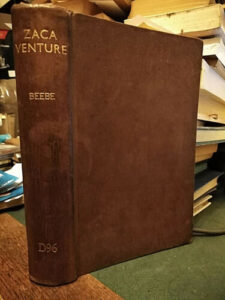
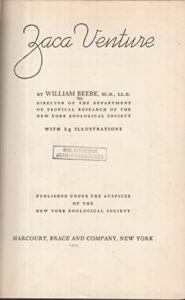
The Zaca is a two masted black diesel schooner, one hundred and eighteen feet over all, with a gross tonnage of eighty four; Templeton Crocker is her owner, tanned a pleasant ochraceous tawny, five feet ten over all, with a refined tonnage of about twelve stone. The two, in juxtaposition, with a hand-picked captain and crew, set themselves to aid and abet a scientific expedition. The Invitation was to spend two months on the Zaca in the Gulf of California; the Acceptance materialized as the Twenty-fourth Expedition of the Department of Tropical Research of the New York Zoological Society; the Route included Cedros Island, Cape San Lucas, Guaymas, Inez Bay, the Banks of Punta Arena and Gorda, Mazatlan, and Clarion Island; the Chronology was the year nineteen hundred and thirty six from March twenty fifth to May twenty fifth, San Diego to San Diego; the Personnel included Templeton Crocker, Master and Owner, Alfred Pedersen, Captain, three members of my Staff, John Tee Van, General Associate, Jocelyn Crane, Technical Associate, George Swanson, Artist, myself, and a crew of fifteen, French, Norwegian, Latvian, Irish, Swedish, German, and Samoan. And there was also Toshio Asaeda, Japanese artist, photographer, preparateur; a walking, sleepless incarnation of the word Work. Our trip took on the character of the spoor of a drop of water meandering down a dusty windowpane, in that we made decisions suddenly as to the details of the exact route, and adapted our plans to contingencies and the incidence of favorable locations. From our basic plan we never swerved, which was to spend as little time as possible in disconnected and uncorrelated dredging, seining, and diving, but to concentrate our researches in two or three zoologically interesting places. These proved to be the Inez Bay region, Cape San Lucas and the adjoining Banks, and Clarion Island. Whatever of value may accrue to our published scientific results will be due to this course of action. (From the Preface)
— David DeWitt
Posted in Collectibles, Flynn-related

— David DeWitt
Posted in Collectibles, Flynn-related

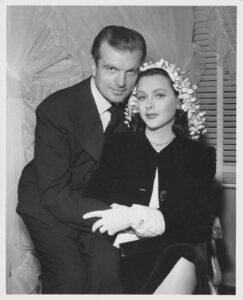
Dear Flynnstones,
Anthony Loder, the son of Hedy Lamarr, revealed during his recent stay in Vienna that in 2024 the new KaDeWe-department store will open here and bear Hedy‘s Hollywood stage name.
It will also host a café highlighting her career and a rooftop garden in her honor. The whole estate will be prominently on display on all levels of the building.
Enjoy,
— shangheinz
Posted in Flynn-related, Main Page, Shangheinz Shanties

Dear Flynnstones,
when the Australian photo model George Lazenby got the call up to follow Sean Connery as 007, he expressed an interesting take on acting in an early interview.
“What about your Australian accent- do you think there‘ll be any problems as far as international filmgoers are concerned?“
“No, I don‘t think so. I saw a film recently with Errol Flynn, and he still had traces of an Australian accent, and he was accepted. I think if you do what you feel and be natural, people accept you as a person. If you try and be an actor, which I am not trying to be, they may not accept me, because I am not an actor, if you know what I mean…“
Enjoy,
— shangheinz
Posted in Flynn and..., Flynn-related, Main Page, Shangheinz Shanties
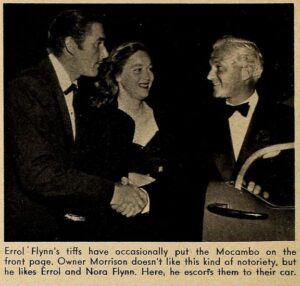
Dear Flynnstones,
the Mocambo tops the list of nightclub brawls during the era of Errol.
But Flynn fisticuffs involved only an open hand, an egg and a no show by our Hollywood hero: jhgraham.com…
Enjoy,
— shangheinz
Posted in Flynn and..., Flynn-related, Shangheinz Shanties
Dear Flynnstones,
a tribute to the golden era of Hollywood will hit the the big screen this Christmas. The title Baby-lon seems fit. At first glance, Brad Pitt must have channeled Errol Flynn with a little Indy Jones or rather Peter O‘ Toole in „My favorite Year“ for his role. Calling it overacting would be an understatement. Homage or fromage is for you to decide.
Enjoy,
— shangheinz
Posted in Film Trailers, Flynn-related, Main Page, Shangheinz Shanties
Many of you are familiar with the app known as Twitch. Basically, it is a live streaming app popular around the world and one of its categories is live action electronic game streaming. You can download the app on their website to follow Errol Flynn’s grandson known professionally as Sean (Rio) Flynn in the TV series Zoey 101, Devious Maids, Hatfield and McCoys: Bad Blood, Return of the Killer Shrews, Scorched, Family Guy, Simon Birch, Sliders, and The Last of Robin Hood, among others. He also runs the social media related business Donatello Arm which creates 3D images using state of the art robotic arms to create high end product rotatable product images. You can learn more about that below. Today, he is introducing his new streaming gaming channel “SeanRio” on Twitch.

Check out the schedule and subscribe (it’s free!) to watch Sean Rio Flynn do battle live playing your favorite games! PLEASE SHARE THIS POST!
A message from Rory Flynn about Donatello Arm Published previously on the blog:
— David DeWitt
Posted in Flynn-related, Friends & Family, Main Page, Promo

Dear Flynnstones,
this weekend finally saw the release of the latest film from Flashdance director Adrian Lyne “Deep Water“. It features the classical love triangle of a woman, a man and a secret. The story follows, if not entirely, the whodunnit novel from Patricia Highsmith starring stunning new Bond girl Ana de Armas and Ben Affleck, from Good Will Hunting and Flat Man renown.
In the late 1950s Flynn Enterprises announced a project called “Deep Waters“ starring French actress Corinne Calvet and her Prince Charming husband Jeffrey Stone to be filmed by Flynntimo manager Barry Mahon in the South of France, Spain and Tangiers.
“The story is woven around the hidden treasure lost, when Freddie McEvoy’s yacht went down in a storm. Quite a yarn if truth were told.“ (Hedda Hopper)
The script to the never made movie was auctioned off online on the 15th December 2005.
The buyer is a keeper.
The secret if Errol‘s best man was murdered has been buried deep ever since.
Enjoy,
— shangheinz
Posted in Flynn-related, Main Page, Shangheinz Shanties
ChocoTheme by .css{mayo} | powered by WordPress